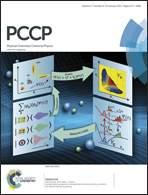Analysis of computational models for an accurate study of electronic excitations in GFP
Abstract
Using the chromophore of the green fluorescent protein (GFP), the performance of a hybrid RI-CC2/polarizable embedding (PE) model is tested against a quantum chemical cluster approach. Moreover, the effect of the rest of the protein environment is studied by systematically increasing the size of the cluster and analyzing the convergence of the excitation energies. It is found that the influence of the environment of the chromophore can accurately be described using a polarizable embedding model with only a minor error compared to a full quantum chemical description. It is also shown that the treatment of only a small region around the chromophore is only by coincidence a good approximation. Therefore, such cluster approaches should be used with care. Based on our results, we suggest that polarizable embedding models, including a large part of the environment to describe its effect on biochromophores on top of an accurate way of describing the central subsystem, are both accurate and computationally favourable in many cases.


 Please wait while we load your content...
Please wait while we load your content...